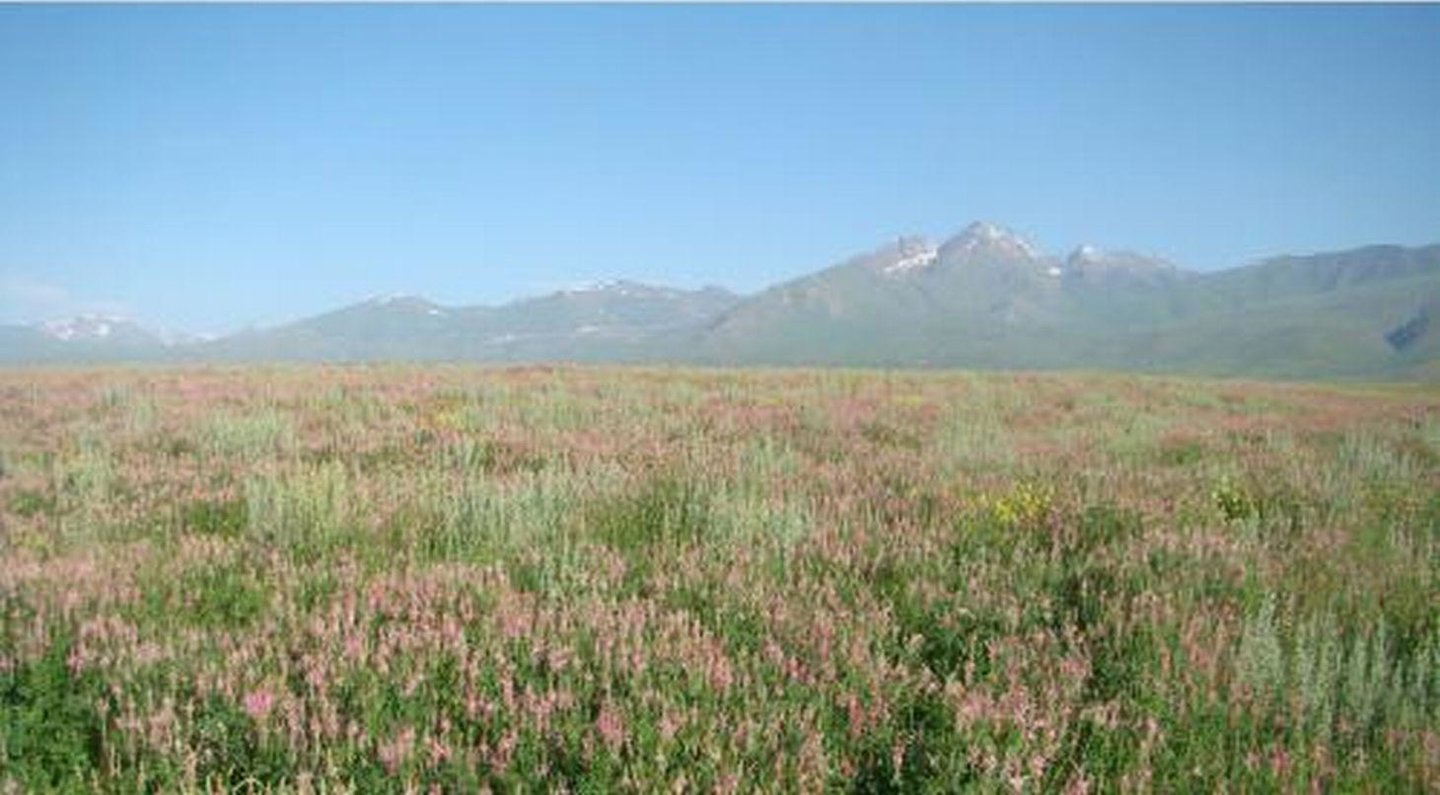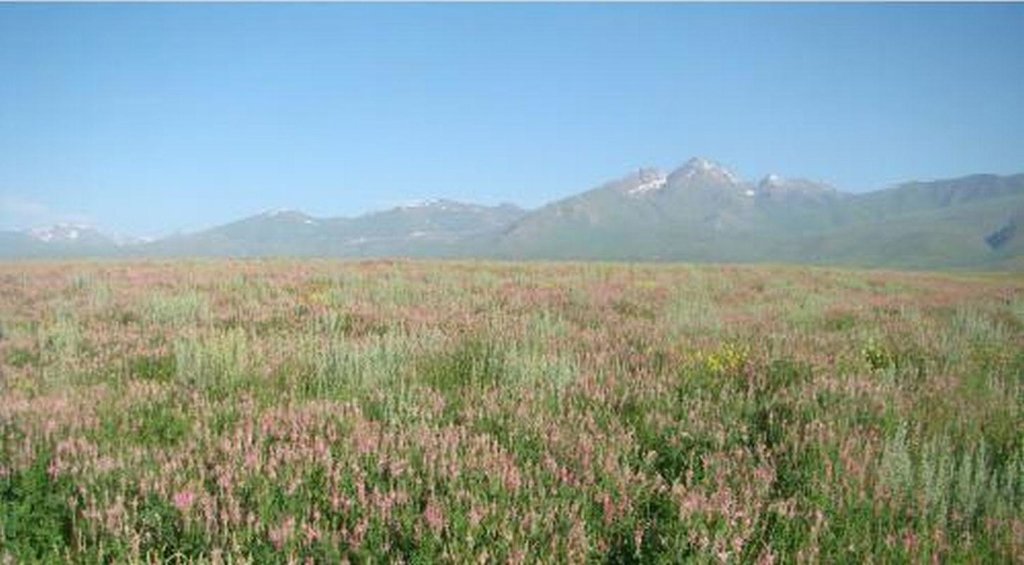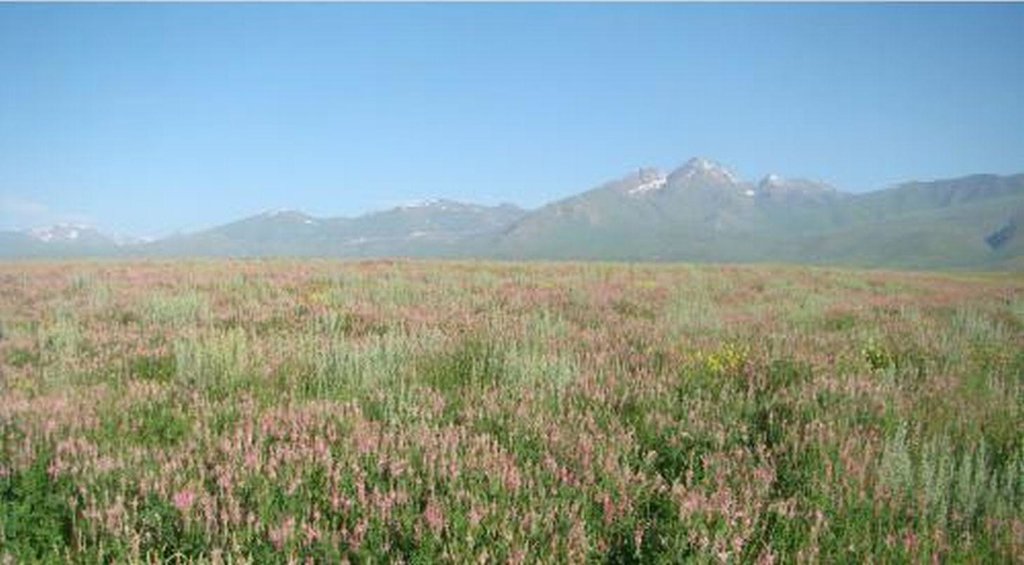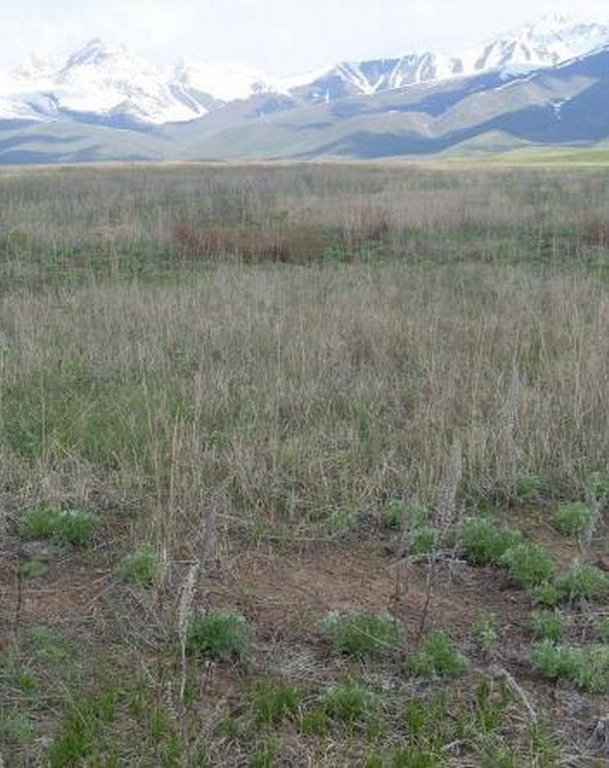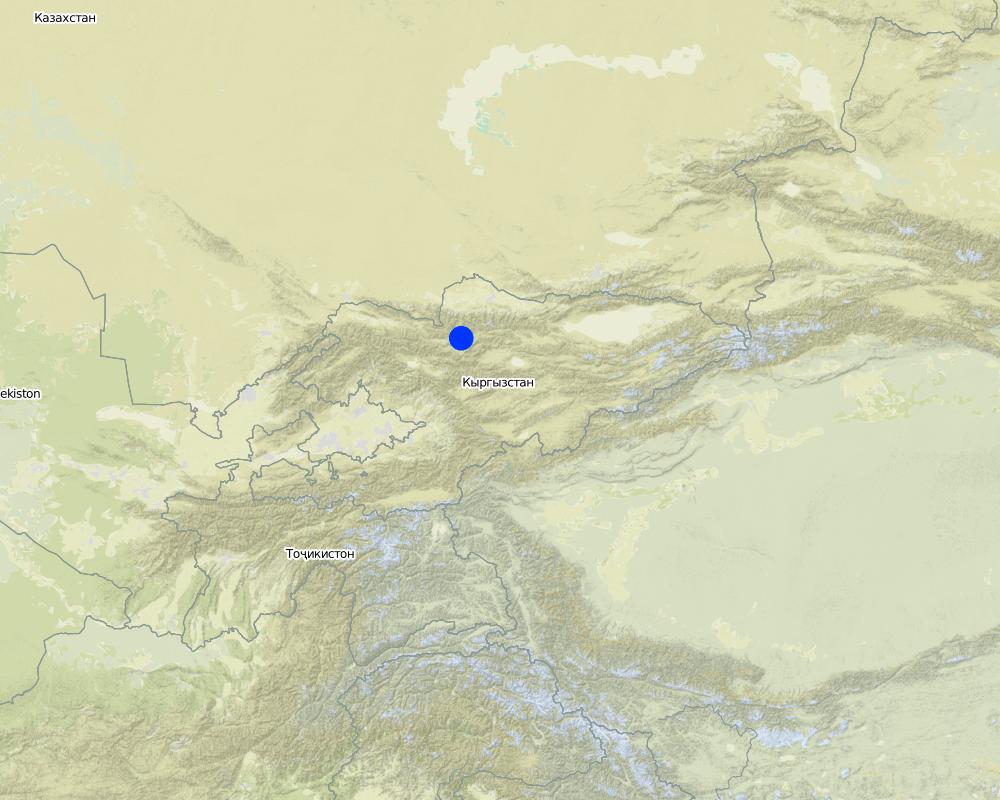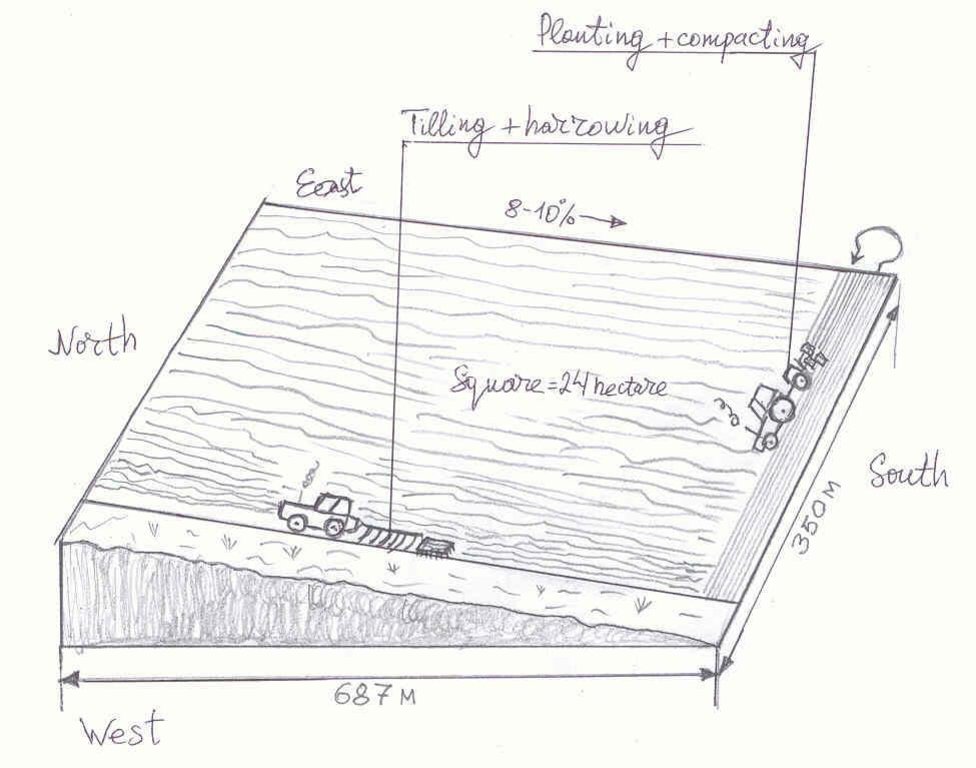Cultivation of sainfoin on high mountain pastures – Suusamyr Valley (in the frame of CACILM) [Kyrgyzstan]
- Creation:
- Update:
- Compiler: Abdybek Asanaliev
- Editor: –
- Reviewer: Alexandra Gavilano
Kyrgyzstan - Central Asian Countries Initiative for Land Management (CACILM/ИСЦАУЗР)
technologies_963 - Kyrgyzstan
- Full summary as PDF
- Full summary as PDF for print
- Full summary in the browser
- Full summary (unformatted)
- Cultivation of sainfoin on high mountain pastures – Suusamyr Valley (in the frame of CACILM): Des. 27, 2016 (inactive)
- Cultivation of sainfoin on high mountain pastures – Suusamyr Valley (in the frame of CACILM): Maart 21, 2017 (inactive)
- Cultivation of sainfoin on high mountain pastures – Suusamyr Valley (in the frame of CACILM): Aug. 3, 2017 (public)
View sections
Expand all Collapse all1. General information
1.2 Contact details of resource persons and institutions involved in the assessment and documentation of the Technology
Key resource person(s)
land user:
Ibraimov 2 Section 2.5.3.2 cont Section 2.5.4.1 Section 2.5.4.2 Section 2.5.4.2 cont Section 2.6.1 Section 2.6.2 Section 2.7.1 - 2.7.3 Section 2.7.4 - 2.7.5 Section 2.7.6 - 2.7.7 Section 2.7.8 - 2.7.9 Section 2.7.10 - 2.7.14 Section 2.7.15 - 2.7.18 Section 2.8.1 - 2.8.4 Section 2.8.5 - 2.8.7 Section 2.8.8.1 - 2.8.8.3 Section 2.8.8.4 - 2.8.8.6 Section 2.8.9.1 - 2.8.9.2 Section 2.8.9.3 - 2.8.9.5 Section 2.8.10.1 - 2.8.10.2 Section 2.8.10.3 - 2.8.10.4 Section 2.8.11 Section 3.1.1.1 Section 3.1.1.2 Section 3.1.1.3 Section 3.1.1.4 Section 3.1.2 Section 3.1.3.1 Section 3.1.3.2 Section 3.1.3.3 Section 3.1.3.4 Section 3.1.4 Section 3.1.5 Section 3.2 Section 3.3 Section 3.4 ANNEX 1 ANNEX 2 ANNEX 3 Approve display Change log Questionnaire info Quality review/publication Reviewer records Add reviewer Manage reviewer records List all reviewer records Manage own records Downloads -QT Basic English - 432kb French - 463kb Spanish - 589kb Portuguese - 864kb Russian - 848kb Chinese - 805kb Turkish - 927kb -Picture format instructions Using IrfanView - 137kb IrfanView - 1.46MB WOCAT homepage Technology A new database is functional since August 4th 2016. Adding of new Technologies must be done using the new system. The migration of the WOCAT data to the new system will be done during the first half of 2017. It is possible to edit Technologies (which were added to the old database) in the new system once the migration of the data to the new system has been achieved. We will keep you informed about the migration process. Please email any enquiries or errors to wocat@cde.unibe.ch. Technology code: T_KYR004en PART 1: GENERAL INFORMATION 1.1 Contributing SLM specialist(s) Main contributor: Asanaliev, Abdybek Data collection date: 2011-01-14 List
Farmer in Susamyr valley
Kyrgyzstan
land user:
Usubaliev Baibek
996 (312) 566 318
b.usubaliev@up.elcat.kg
ELCAT
Toktanaliev Street, # 4 A, room # 212,
Kyrgyzstan
land user:
Duishenaaly uulu Urmat
Suusamyr Village
Kyrgyzstan
Name of project which facilitated the documentation/ evaluation of the Technology (if relevant)
Central Asian Countries Initiative for Land Management (CACILM I)Name of the institution(s) which facilitated the documentation/ evaluation of the Technology (if relevant)
1.3 Conditions regarding the use of data documented through WOCAT
When were the data compiled (in the field)?
14/01/2011
The compiler and key resource person(s) accept the conditions regarding the use of data documented through WOCAT:
Ja
2. Description of the SLM Technology
2.1 Short description of the Technology
Definition of the Technology:
Conservation of soil fertility through the cultivation of sainfoin (perennial legume plants)
2.2 Detailed description of the Technology
Description:
The Suusamyr Plain is located in the South-West of Chui Valley. Generally, this zone, located at 2000-3800 meters above sea level is used by farmers as summer pastures. Farmers are practicing agro-pastoralism by grazing animals and at the same time producing winter fodder for their livestock. They cultivate mainly barley and sometimes perennial grass.
The territory of the local administration of the Aiyl Okrug “Suusamyr” includes 6645 hectares of arable land. In 2009 about 2500 hectares were cultivated with cereals (including 1950 ha of barley) and 250 ha with sainfoin. As a result of the monoculture of cereals, weeds, pests, and insects accumulate on the fields and the soil fertility is declining. These are direct and indirect indicators of soil degradation.
The main cultivated perennial legume is sainfoin. However,farmers are short of sainfoin seeds. Most of them cultivate sainfoin for hay making and consider the seed production as non profitable.
Fallow is maintained free from weed during the vegetation season. As fallow is weed free and accumulates the soil moisture it has synergy effect to harvest high yield of barley grain. This fallow is kept during one vegetation season and applied by other farmers during next season. Crop rotation cycle is 5 years including 1 year-fallow period (1year-fallow period, 1year for barley planting and 3 years for sainfoin planting). Barley is planted into the fallow.
Sainfoin improves the soil structure as a result of high rizo-biomasses (237-333 kg/ha). Sainfoin is able to accumulate 194 -178 kg/ha of biological nitrogen providing sufficient nitrogen fertilization for two consecutive cropping seasons. Sainfoin can be cultivated at altitudes from 700 to 3400 m above sea level (G. Balian, 2004). Sainfoin is a high nectar producting crop, allowing farmers to produce 150 kg of honey from 1 hectare of sainfoin during a vegetation period. As the result of insect pollination, an increase in seed production of between 100 and 200 kg/ha has been observed.
Purpose of the Technology: Soil fertility conservation through crop rotation of barley with the perennial grass sainfoin (Onobrichis sativa).
Establishment / maintenance activities and inputs: Farmer Ibraimov Azimjan has 25 hectares of private land and rents other land from neighboring farmers. UNDP’s project procured seeds of sainfoin and covered expenditures for tillage and planting. The farmer’s responsibility is to distribute produced seeds among other farmers which are able to expand their areas under sainfoin cultivation. The farmers maintains crop rotation.
Fields are located in the foothills at an elevation of 2038-2200 m above sea level. Plowing is conducted along the slope. But planting is done across to the tilling direction, horizontally along the field (contour planting drilling). This technology increases vegetation cover and after harvesting stubbles remain
Natural / human environment: Agriculture in Suusamyr Valley is based on animal husbandry which is kept on pastures during three seasons (spring, summer and autumn). But farmers practice agro-pastorals. They have private arable land and produce cereals and forage crops. The Local Government “Suusamyr” has 6645 hectares of arable land including 561 hectares from the Distribution Found (state regulated land). Farmers are not subsidized by the Government.
The farmer Ibraimov Azimjan has 25 hectares of private land and rents other land from the neighboring farmers. In 2009 UNDP’s project procured basic seeds of sainfoin and covered the expenditures for tillage and planting. UNDP’s project organized several workshops for farmers on technology of cereals and forage crops cultivation. Project manager also had finance support in field inspection of sainfoin seed and barley.
Farmer’s responsibility is to distribute seed among other farmers which able to expand their areas under sainfoin. Farmer has resources to guard the field from grazing of animals during the vegetation period, harvest and transportation of seed. Azimjan also organized the seed cleaning and storage. Project’s management developed the rules on seed distributions and sale.
The farmer should produce sainfoin and barley in order to get benefit. Farmer’s responsibility is to distribute seed to other farmers which able to expand the area under sainfoin and barley. Name of sainfoin variety is “Belek”, barley variety is “Kylym”, they are developed in research centers of Kyrgyz Republic.
The population of the Aiyl Okrug “Suusamyr” is 6400. The Local Government has no human resources for field activities. There are six villages at the territory of this Local Government. All fields and villages are connected by dirt roads. The electricity is supplied on regularly basis. People have drinking water supplies.
Farmer’s fields are located at foothills of 2038-2200 m above sea level. The type of land use is rainfed. Some irrigated channels which were developed in Soviet time are destroyed now. The fields are infested mainly with wild Oat, Couch-grass, spp. pigweed, wormwood and others.
The farmers cultivate cereals as monoculture. Some of them plant the sainfoin. Additionally, farmers cultivate potato on a total area of 180-200 hectares. The varieties are from local breeders (Nevsky, Cardinal) and introduced varieties from seed Firm “Agrico” and “NZPC” (Picasso, Sante and Mondial).
The main type of soil is chestnut (light chestnut soil and dark chestnut soil). The potential fertility of these soils is high but due to the lack of crop rotation, plant protection activities, fertilizer application, soil degradation is going on. There are no soil maps in the office of local administration except for those which were developed during the Soviet time.
2.3 Photos of the Technology
2.5 Country/ region/ locations where the Technology has been applied and which are covered by this assessment
Country:
Kyrgyzstan
Region/ State/ Province:
Kyrgyz Republic, Chui oblast
Further specification of location:
Jayl district
Comments:
Boundary points of the Technology area: The sainfoin is cultivated on mountain pastures from 800 meters to 3000 meters above sea level
Map
×2.6 Date of implementation
If precise year is not known, indicate approximate date:
- less than 10 years ago (recently)
2.7 Introduction of the Technology
Specify how the Technology was introduced:
- through projects/ external interventions
Comments (type of project, etc.):
The Technology was developed by the Kyrgyz Livestock and Pasture Research Institute and applied by the UNDP Project "Demonstration Sustainable Mountain Pasture Management in Suusamyr Valley, Kyrgyzstan"
3. Classification of the SLM Technology
3.1 Main purpose(s) of the Technology
- create beneficial economic impact
3.2 Current land use type(s) where the Technology is applied

Cropland
- Annual cropping
- Perennial (non-woody) cropping

Grazing land
Extensive grazing land:
- Semi-nomadism/ pastoralism
- Ranching
Intensive grazing/ fodder production:
- Improved pastures
- agro-pastoralism
Comments:
Major land use problems (compiler’s opinion): Decline of soil fertility due to longstanding cultivation of barley on the field. Annual conventional plowing is affecting the mineralization of soil humus.
Major land use problems (land users’ perception): Decline of barley yield. The quality of barley grain also is declining.
Semi-nomadism / pastoralism: Yes
Ranching: Yes
Improved pasture: Yes
Mixed: (eg agro-pastoralism, silvo-pastoralism): Yes
Future (final) land use (after implementation of SLM Technology): Cropland: Cp: Perennial (non-woody) cropping
Livestock is grazing on crop residues
If land use has changed due to the implementation of the Technology, indicate land use before implementation of the Technology:
Cropland: Ca: Annual cropping
3.3 Further information about land use
Comments:
Water supply: rainfed, mixed rainfed - irrigated, rainfed
Number of growing seasons per year:
- 1
Specify:
Longest growing period in days: 120Longest growing period from month to month: April - August
Livestock density (if relevant):
25-50 LU /km2
3.5 Spread of the Technology
Specify the spread of the Technology:
- evenly spread over an area
If the Technology is evenly spread over an area, indicate approximate area covered:
- 0.1-1 km2
Comments:
Total area covered by the SLM Technology is 0,24 m2.
3.6 SLM measures comprising the Technology

agronomic measures
- A1: Vegetation/ soil cover
- A3: Soil surface treatment

vegetative measures
- V2: Grasses and perennial herbaceous plants
Comments:
Main measures: agronomic measures
Secondary measures: vegetative measures
3.7 Main types of land degradation addressed by the Technology

chemical soil deterioration
- Cn: fertility decline and reduced organic matter content (not caused by erosion)

biological degradation
- Bc: reduction of vegetation cover
- Bh: loss of habitats
Comments:
Main type of degradation addressed: Cn: fertility decline and reduced organic matter content, Bh: loss of habitats
Secondary types of degradation addressed: Bc: reduction of vegetation cover
Main causes of degradation: soil management (Lack of fertilizes), over-exploitation of vegetation for domestic use, Heavy / extreme rainfall (intensity/amounts) (Usually in dry weather plants have a vertical appearance. After heavy gales they lose their vetical standing and they droop. This is lodging. During lodginh of plants the yield of seed is decreasing.), land tenure
Secondary causes of degradation: crop management (annual, perennial, tree/shrub) (As a result of the monoculture of cereals, weeds, pests, and insects accumulate on the fields and the soil fertility is declining.), other human induced causes (specify) (inappropriate soil management)
3.8 Prevention, reduction, or restoration of land degradation
Specify the goal of the Technology with regard to land degradation:
- prevent land degradation
- reduce land degradation
Comments:
mitigation land degradation, rehabilitation / reclamation of denuded land
4. Technical specifications, implementation activities, inputs, and costs
4.1 Technical drawing of the Technology
4.2 Technical specifications/ explanations of technical drawing
Fields are located on South exposition of the foothills of the Kyrgyz Ala-Too Mountains in the Northern part of the Suusamyr valley. The length of the sainfoin field is 687 meters, and its width is 350 meters. Slope steepness is 8-10 %.
Tilling is conducted along the slope by a tractor K-700, with harrowing being conducted at the same time. The depth of tilling is 20-22 cm. Planting is conducted across to plowing direction. The date for sainfoin sowing is the first ten days of May. The seeds required are 80 kg/ha. Depth of sowing is 4 cm. This field is situated 8 kilometers from central Suusamyr village, reachable on a bad dirt road.
Location: Suusamyr Valley. Jaiyl raion / Chui oblast / Kyrgyzstan
Date: 11.01.2011
Technical knowledge required for field staff / advisors: high (Special training is requested)
Technical knowledge required for land users: low (Field demonstration is needed)
Main technical functions: control of dispersed runoff: impede / retard, stabilisation of soil (eg by tree roots against land slides), increase in organic matter, increase in nutrient availability (supply, recycling,…)
Secondary technical functions: improvement of subsoil structure (hardpan)
Vegetative measure: field planted by perennual grass
Vegetative material: C : perennial crops
Number of plants per (ha): 3000000
Spacing between rows / strips / blocks (m): 0.15
Width within rows / strips / blocks (m): 0.15
Vegetative measure: Vegetative material: C : perennial crops
Vegetative measure: Vegetative material: C : perennial crops
Vegetative measure: Vegetative material: C : perennial crops
Perennial crops species: Sainfoin os sowed with planting machine C3-3.6. The distance between colters is 15 cm.
4.3 General information regarding the calculation of inputs and costs
other/ national currency (specify):
KGS
Indicate exchange rate from USD to local currency (if relevant): 1 USD =:
45.0
Indicate average wage cost of hired labour per day:
8.00
4.4 Establishment activities
| Activity | Type of measure | Timing | |
|---|---|---|---|
| 1. | Tilling | Vegetative | End of April. Once in 3 years |
| 2. | Planting | Vegetative | End of April. Once in 3 years |
4.5 Costs and inputs needed for establishment
| Specify input | Unit | Quantity | Costs per Unit | Total costs per input | % of costs borne by land users | |
|---|---|---|---|---|---|---|
| Labour | establishment costs | hectare | 1.0 | 187.0 | 187.0 | |
| Labour | labour | person/hour | 0.8 | 128.0 | 102.4 | 100.0 |
| Plant material | seeds | hecatre | 1.0 | 108.0 | 108.0 | |
| Plant material | seeds | kg | 75.0 | 2600.0 | 195000.0 | |
| Other | fuel | liter | 58.0 | 321.0 | 18618.0 | |
| Total costs for establishment of the Technology | 214015.4 | |||||
Comments:
Duration of establishment phase: 1 month(s)
4.6 Maintenance/ recurrent activities
| Activity | Type of measure | Timing/ frequency | |
|---|---|---|---|
| 1. | Harvesting | Vegetative | annually |
| 2. | Cleaning of seed | Vegetative | annually |
| 3. | Cleaning of seed | Vegetative |
4.7 Costs and inputs needed for maintenance/ recurrent activities (per year)
Comments:
Machinery/ tools: Tractor MTZ-80, Self-Proppeled Combine Enisey-600, Seed Cleaning Machine SM-4
The above costs were affected by the length of the field and number of turn points during tilling and planting.
4.8 Most important factors affecting the costs
Describe the most determinate factors affecting the costs:
The price of sainfoin seeds is very high. The slope is increasing the fuel consumption of the tractor, and prices for fuel are raising. Contour tilling (also planting) by big tractor (K-700) is further increasing fuel consumption, because the number of turning-points are increased. Soil depth is not increasing cost in a major way, because soil structure in the area is comparatively good and the tractor is powerful.
All costs are calculated for 1 hectare of sainfoin. National currency is KGS. Exchange rate was approximately 45 KGS for 1 US Dollar in 2009 and 2010.
5. Natural and human environment
5.1 Climate
Annual rainfall
- < 250 mm
- 251-500 mm
- 501-750 mm
- 751-1,000 mm
- 1,001-1,500 mm
- 1,501-2,000 mm
- 2,001-3,000 mm
- 3,001-4,000 mm
- > 4,000 mm
Agro-climatic zone
- sub-humid
Thermal climate class: temperate
5.2 Topography
Slopes on average:
- flat (0-2%)
- gentle (3-5%)
- moderate (6-10%)
- rolling (11-15%)
- hilly (16-30%)
- steep (31-60%)
- very steep (>60%)
Landforms:
- plateau/plains
- ridges
- mountain slopes
- hill slopes
- footslopes
- valley floors
Altitudinal zone:
- 0-100 m a.s.l.
- 101-500 m a.s.l.
- 501-1,000 m a.s.l.
- 1,001-1,500 m a.s.l.
- 1,501-2,000 m a.s.l.
- 2,001-2,500 m a.s.l.
- 2,501-3,000 m a.s.l.
- 3,001-4,000 m a.s.l.
- > 4,000 m a.s.l.
5.3 Soils
Soil depth on average:
- very shallow (0-20 cm)
- shallow (21-50 cm)
- moderately deep (51-80 cm)
- deep (81-120 cm)
- very deep (> 120 cm)
Soil texture (topsoil):
- coarse/ light (sandy)
- medium (loamy, silty)
Soil texture (> 20 cm below surface):
- coarse/ light (sandy)
- medium (loamy, silty)
Topsoil organic matter:
- high (>3%)
- medium (1-3%)
If available, attach full soil description or specify the available information, e.g. soil type, soil PH/ acidity, Cation Exchange Capacity, nitrogen, salinity etc.
medium-high soil fertility, soil water storage = medium, soil drainage = good
5.4 Water availability and quality
Ground water table:
5-50 m
Availability of surface water:
good
Water quality (untreated):
good drinking water
Is water salinity a problem?
Nee
Comments and further specifications on water quality and quantity:
good drinking water,
5.5 Biodiversity
Species diversity:
- medium
Habitat diversity:
- medium
Comments and further specifications on biodiversity:
Earthworms and gnawing animals inhabit on the field
5.6 Characteristics of land users applying the Technology
Sedentary or nomadic:
- Semi-nomadic
- Nomadic
Market orientation of production system:
- subsistence (self-supply)
- mixed (subsistence/ commercial
Off-farm income:
- less than 10% of all income
Relative level of wealth:
- average
- very rich
Individuals or groups:
- groups/ community
Level of mechanization:
- mechanized/ motorized
Gender:
- women
- men
Indicate other relevant characteristics of the land users:
Land users applying the Technology are mainly common / average land users
Difference in the involvement of women and men: This technology is very strongly supported by Pasture Users Association, who is interesting in improving forage quantity and quality. Sainfoin's hay has high protein content in comparison with natural hay. Therefore the association is interested in expansion of sainfoin fields.
Population density: < 10 persons/km2
Annual population growth: 1% - 2%
and own 4% of the land (10).
and own 85% of the land (70).
and own 10% of the land (19).
and own 1% of the land (1).
Off-farm income specification: Some farmers sell agricultural and processing products in the shops located along the highway Bishkek-Osh and in the villages. Some of the villagers provide taxi services from Suusamyr to Bishkek.
Market orientation of production system: subsistence (self-supply), subsistence (self-supply), mixed (subsistence/ commercial, commercial/ market, commercial/ market
5.7 Average area of land owned or leased by land users applying the Technology
- < 0.5 ha
- 0.5-1 ha
- 1-2 ha
- 2-5 ha
- 5-15 ha
- 15-50 ha
- 50-100 ha
- 100-500 ha
- 500-1,000 ha
- 1,000-10,000 ha
- > 10,000 ha
Is this considered small-, medium- or large-scale (referring to local context)?
- medium-scale
5.8 Land ownership, land use rights, and water use rights
Land ownership:
- state
- individual, titled
Land use rights:
- individual
Water use rights:
- communal (organized)
5.9 Access to services and infrastructure
health:
- poor
- moderate
- good
education:
- poor
- moderate
- good
technical assistance:
- poor
- moderate
- good
employment (e.g. off-farm):
- poor
- moderate
- good
markets:
- poor
- moderate
- good
energy:
- poor
- moderate
- good
roads and transport:
- poor
- moderate
- good
drinking water and sanitation:
- poor
- moderate
- good
financial services:
- poor
- moderate
- good
Extension Service:
- poor
- moderate
- good
6. Impacts and concluding statements
6.1 On-site impacts the Technology has shown
Socio-economic impacts
Production
crop production
Quantity before SLM:
19 c/ha
Quantity after SLM:
23 c/ha
fodder production
Quantity before SLM:
500 bales
Quantity after SLM:
550 bales
fodder quality
Income and costs
expenses on agricultural inputs
Quantity before SLM:
0
Quantity after SLM:
24 ha
diversity of income sources
Socio-cultural impacts
food security/ self-sufficiency
cultural opportunities
community institutions
Quantity before SLM:
0
Quantity after SLM:
1
conflict mitigation
Quantity before SLM:
0
Quantity after SLM:
2 training
Ecological impacts
Water cycle/ runoff
surface runoff
Soil
soil cover
Quantity before SLM:
80%
Quantity after SLM:
95%
soil compaction
soil organic matter/ below ground C
Biodiversity: vegetation, animals
habitat diversity
6.2 Off-site impacts the Technology has shown
buffering/ filtering capacity
damage on neighbours' fields
Quantity after SLM:
5ha
Comments/ specify:
Project recruts a security guard to protect sainfoin field since May. And at the same time he watches the neighbours fields.Therefore damage on it is reduced.
Honey collection is improved
6.3 Exposure and sensitivity of the Technology to gradual climate change and climate-related extremes/ disasters (as perceived by land users)
Gradual climate change
Gradual climate change
| Season | Type of climatic change/ extreme | How does the Technology cope with it? | |
|---|---|---|---|
| annual temperature | increase | not well |
Climate-related extremes (disasters)
Meteorological disasters
| How does the Technology cope with it? | |
|---|---|
| local rainstorm | well |
Climatological disasters
| How does the Technology cope with it? | |
|---|---|
| drought | well |
Hydrological disasters
| How does the Technology cope with it? | |
|---|---|
| general (river) flood | not well |
Other climate-related consequences
Other climate-related consequences
| How does the Technology cope with it? | |
|---|---|
| reduced growing period | not well |
6.4 Cost-benefit analysis
How do the benefits compare with the establishment costs (from land users’ perspective)?
Short-term returns:
very positive
Long-term returns:
very positive
How do the benefits compare with the maintenance/ recurrent costs (from land users' perspective)?
Short-term returns:
positive
Long-term returns:
positive
6.5 Adoption of the Technology
- single cases/ experimental
Of all those who have adopted the Technology, how many have did so spontaneously, i.e. without receiving any material incentives/ payments?
- 0-10%
Comments:
1% of land user families have adopted the Technology with external material support
1 land user families have adopted the Technology with external material support
Comments on acceptance with external material support: Saifoin seed was provided to farmers with lower price than commercially available seeds.
Comments on spontaneous adoption: There is little trend towards (growing) spontaneous adoption of the technology.
There is a little trend towards spontaneous adoption of the Technology
Comments on adoption trend: Some farmers are aware about the production of high quality forage and want to be ready to be protected from drought. During drought periods the yield of natural vegetation is less, but the yield of sainfoin’ is constant.
6.7 Strengths/ advantages/ opportunities of the Technology
| Strengths/ advantages/ opportunities in the land user’s view |
|---|
|
Keeping the fields as fallow is not profitable for ordinary farmers. It can be done by rich farmers. How can they be sustained / enhanced? If there is the increase of returns it is necessary to maintain fallow |
|
There is need in subsidies from the Government in order to distribute cereals and perennial legume seed. How can they be sustained / enhanced? To provide credits for farmers in order for them to buy seed |
|
If there is enough fuel and seed farmers can cultivate sainfoin everywhere, it is very good technology. How can they be sustained / enhanced? The State should subsidy the supply of oil products |
| Strengths/ advantages/ opportunities in the compiler’s or other key resource person’s view |
|---|
|
The winter is very hard in Suusamyr Valley and livestock need enough and quality forage. Sainfoin hay contains high level of protein. How can they be sustained / enhanced? To prepare emergency stocks of hay |
|
Natural vegetation yields for hay making is not so big particularly in drought period. Sainfoin is very productive crop. How can they be sustained / enhanced? To introduce more productive and drought - resistant varieties |
|
Rizo biomass of sainfoin is big and it accumulates the nitrogen. Sainfoin improves the soil fertility. How can they be sustained / enhanced? The cultivation of sainfoin should be rotated in all available fields |
|
Sainfoin is income generating crop because after harvesting of seed sainfoin the straw can be also sold by farmers at the price of 50 som for one hay bale How can they be sustained / enhanced? To conduct marketing researches for sale of hay |
|
This Technology also protects the soil surface from the erosion in the result of strong density of plants. How can they be sustained / enhanced? To increase the sowing rate up to 90 kg/ha |
6.8 Weaknesses/ disadvantages/ risks of the Technology and ways of overcoming them
| Weaknesses/ disadvantages/ risks in the land user’s view | How can they be overcome? |
|---|---|
| Poor farmer is not interested in the Conservation Technology | Awareness raising of the poor farmers is necessary |
| We are having not enough knowledge about the soil conservation possibility legumes | To organize the training of farmers. |
| State legislation about soil protection is not maintained by Local Government and farmers | To monitor the observation of legislation by land users and local authorities |
| There should be Soil fertility protection service. | The Government should finance the establishment of service on soil fertility protection. |
| Weaknesses/ disadvantages/ risks in the compiler’s or other key resource person’s view | How can they be overcome? |
|---|---|
| Lack of good credit system for farmers SWCT. | To lower interest rates of credits while lending farmers for implementation of the Conservation Technology |
| Comparatively high price of certified sainfoin seeds are not available for farmers | Usage of not certified seed by farmers leads to poor yields of sainfoin and cereals. To ensure the supply of high quality seed through distributers’ centers |
| Farmers need special knowledge in order to produce sainfoin seed | To conduct trainings for farmers on seed production technologies. |
|
To consolidate farmers about the effect of sainfoin cultivation for soil fertility some scientists have to do on farm demonstration plots |
Extension services should organize demonstration fields in villages. |
7. References and links
7.2 References to available publications
Title, author, year, ISBN:
Usubaliev B. Annual project activity’s report. “Demonstration sustainable mountains pasture management in the Suusamyr Valley. Kyrgyzstan”. UNDP.- Kyrgyzsran., 2010. Bishkek.
Available from where? Costs?
Project office
Title, author, year, ISBN:
Duishenaaly uulu Urmat.- Report of land management specialist of the “Local Gogernment Suusamyr”, 2010
Available from where? Costs?
Suusamyr Village
Title, author, year, ISBN:
Bekganov Nurkan.- Report of local mobilization specialist of the UNDP project.- 2010
Available from where? Costs?
Suusamyr Village.
Title, author, year, ISBN:
Amankulov Kubanychbek.- Report of statistics specialist of the “Local Gogernment Suusamyr”, 2010
Available from where? Costs?
.Suusamyr Village
Links and modules
Expand all Collapse allLinks
No links
Modules
No modules


